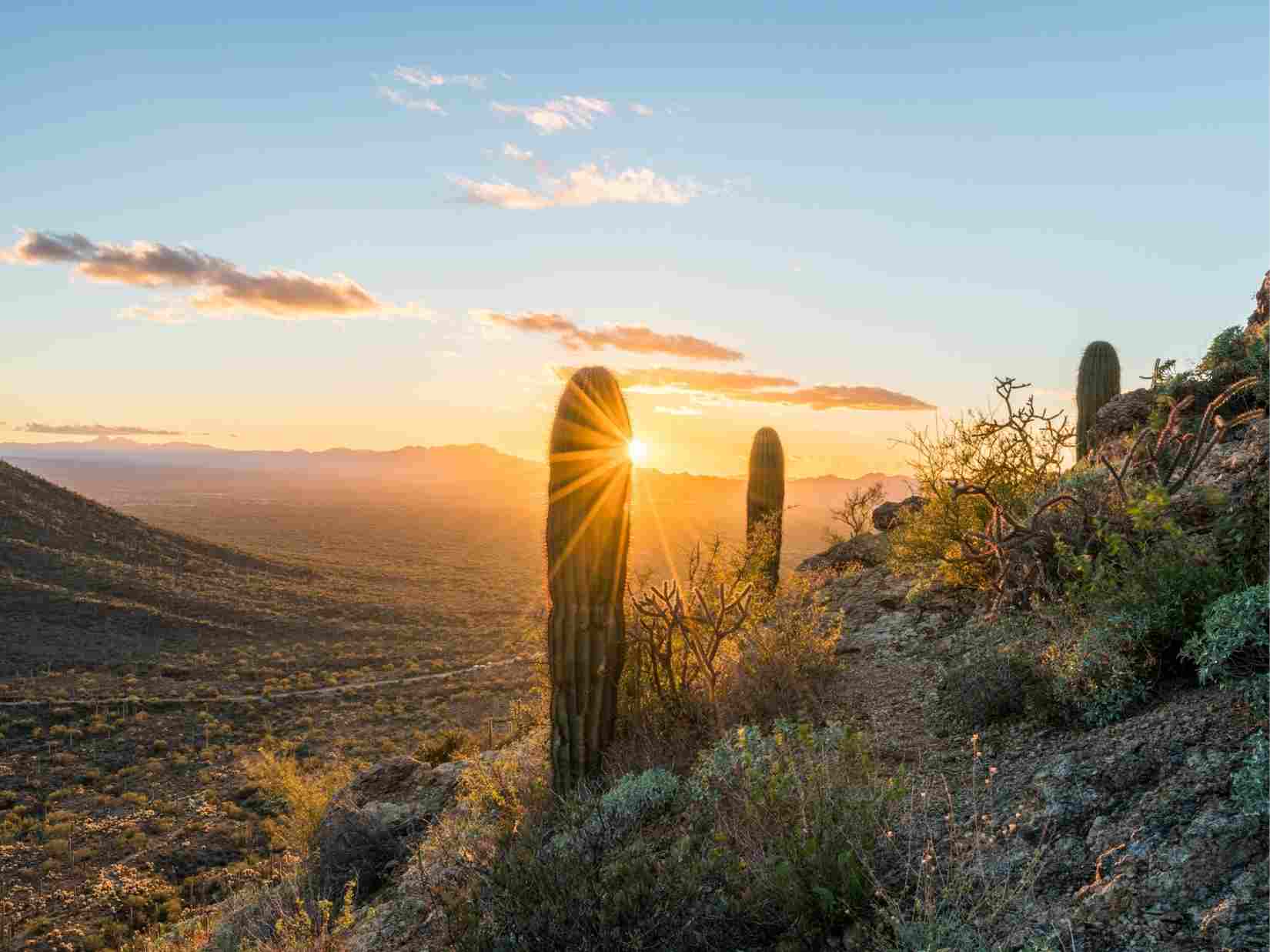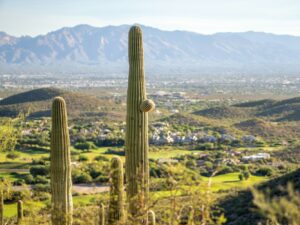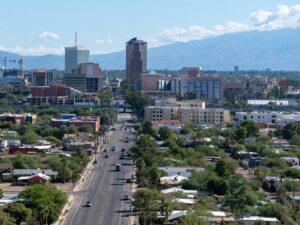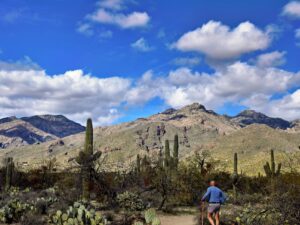Welcome to Tucson, a city nestled just 60 miles north of the U.S./Mexico border, offering a rich mix of Native American, Spanish, and Mexican cultures. Its name comes from the Pima Indian word “schook-sun,” which means a “spring at the foot of a black mountain,” a nod to the area’s mountainous terrain and desert surroundings. Located about 118 miles southeast of Phoenix, Tucson is the second-largest city in Arizona and the 32nd-largest city in the United States. Its metropolitan area is home to just over 980,000 residents, with the city itself numbering over 520,000 according to the 2010 United States Census.
Welcome to Tucson: Diverse Natural Beauty
So what makes the Tucson area so special? Beyond its natural beauty, it’s a diverse combination of factors that offers something for everyone. With more than 630 miles of bike paths in the metropolitan area, it’s clear that its residents have embraced the state’s reputation as a place to truly experience and appreciate the great outdoors. In fact, Tucson hosts El Tour de Tucson, the largest perimeter bicycling event in the Union, with some 10,000 participants every autumn.
Besides its miles of striped bike paths, Tucson also has 72 miles of shared-use paths and more than 100 miles of residential bike routes. It’s no surprise that Tucson was named one of the “Top Five Best Cycling Towns” in the U.S. – and the “Friendliest City” and one of the “Top 10 U.S. Cities to Visit” by Conde Nast Traveler magazine.
And, the U.S. Department of Transportation has designated General Hitchcock Highway – commonly known to residents as the Catalina Highway – as one of “America’s Byways” and “One of the most scenic drives in the nation.” Winding from the base of the Santa Catalina Mountains to Summerhaven, a charming mountain village on Mount Lemmon that sits at an 8,200-foot elevation, the road is a veritable nature drive of ecology, with distinctive saguaro and cholla cacti along the way.
The city’s rich cultural heritage has garnered honors as one of the Top 10 cities for Hispanics in 2009, according to Hispanic magazine, and its thriving business community – especially technology – has resulted in more than 1,200 companies employing in excess of 50,000 Southern Arizona residents, 150 of which are involved with optics and optoelectronics systems and garnering the city with the unofficial nickname of Optics Valley.
In addition, Tucson serves as the home of the University of Arizona, the first university in the state as well as an international hub of astronomical and technological research, and affiliated astronomy efforts such as Kitt Peak National Observatory and Steward Observatory, a joint venture between the University and the Vatican Observatory Research Group and manages multiple telescopes across Southern Arizona.
Welcome to Tucson: Rich and Colorful History
Known as the “Old Pueblo,” Tucson has a rich multicultural history that includes Spanish, Mexican, and Native American influences and centuries-old traditions. According to University of Arizona research, Tucson’s first residents hunted for bison and woolly mammoth between 12,500 and 6,000 B.C.E. Later, in 300 A.D., the Cochise and Hohokam Indian cultures came to farm the area’s rich valley terrain.
In 1692, Spanish missionaries discovered the Indian village S-tukson (which means “black base”), and by 1804, about 1,000 people lived in traditional adobe villages. The 1848 Gold Rush in California attracted even more residents to the area, and Arizona was named the 48th state in 1912.
During World War II, Davis-Monthan Field served as an important training base, bringing an influx of military families to the city, many of whom chose to stay, raise families, and retire here.
As for geography, Mexico is a close neighbor at 60 miles south, and the city was actually part of Mexico when Mexico gained independence from Spain in 1821. But, thanks to the Gadsden Purchase in 1853 (also known as the Treaty of La Mesilla), when the U.S. bought parts of southern Arizona and New Mexico to make way for the construction of a transcontinental railroad, the city became part of the U.S. and was named the capital of what was then known as the Arizona Territory.
The epitome of the “Wild, Wild West” in the 1860s, Tucson was a rough-and-tumble frontier town coming into its own like many other western cities of the day. In fact, the town of Tombstone – where the famous “Shootout at the OK Corral” happened – is just 50 miles southeast of Tucson. The city is still known for its Western roots and culture.
Welcome to Tucson: The Great Outdoors
Tucson sits atop a plain in the Sonoran desert, surrounded by five minor ranges of mountains: the Santa Catalina Mountains and the Tortolita Mountains to the north, the Santa Rita Mountains to the south, the Rincon Mountains to the east, and the Tucson Mountains to the west. The high point of the Santa Catalina Mountains is 9,157-foot Mount Lemmon, the southernmost ski destination in the continental U.S., while the Tucson Mountains feature the 4,687-foot Wasson Peak.
The city’s mild weather and warm, dry climate coax both residents and visitors outside to enjoy the sunshine. The surrounding mountains offer cooler temperatures and an outdoor dichotomy that allows residents to swim, hike, and ski – all on the same day! The average minimum temperature is 54°F (12°C), and the average maximum is 82°F (28°C), while the rainfall is minimal – only about 12 inches annually.
Summer is the warmest time of the year, with hot, dry temperatures in the 100s during the day but comfortable nights normally in the 70s and 80s. The humidity is only about 10 percent in the spring and early summer, resulting in a much drier heat – and a top reason why the state has long been known as a healing destination.
Summer also ushers in a monsoon period in Southern Arizona, which begins on June 15th and ends on September 30th. During this time, the humidity climbs with a buildup of daily cloud cover, which is then followed by afternoon and evening thunderstorms and rainfall. Many Tucsonans welcome the monsoons – which is considered by many residents as its own annual season – as it blocks the bright, warm afternoon sun experienced in early summer and can actually drop temperatures as far as 20 degrees or more.
And don’t forget cooler nights in fall and winter, when it’s not unusual to experience temperature drops in the low 30s. It even snows every once in a while, with skiing and other snow sports the activity of choice for residents at nearby Mt. Lemmon.
Love parks? Tucson is home to several national parks, including Catalina State Park and Saguaro National Park, as well as more than 125 citywide parks for fun and recreation. The city’s climate means that it’s also a golfer’s paradise, with its mix of municipal, private, and unique desert courses designed by Robert Trent Jones Jr., Tom Fazio, Tom Weiskopf, Jack Nicklaus, and other pros.
As for spectator sports, Tucson is home to several professional sports clubs, including two minor league baseball teams, the Tucson Padres, a triple-A affiliate of the San Diego Padres that plays at Kino Veterans Memorial Stadium, and the Tucson Toros, a member team of the independent Golden Baseball League that has made Tucson and its historic Hi Corbett Field its home for much of the past 42 years.
Request your free Tucson Relocation Guide here




